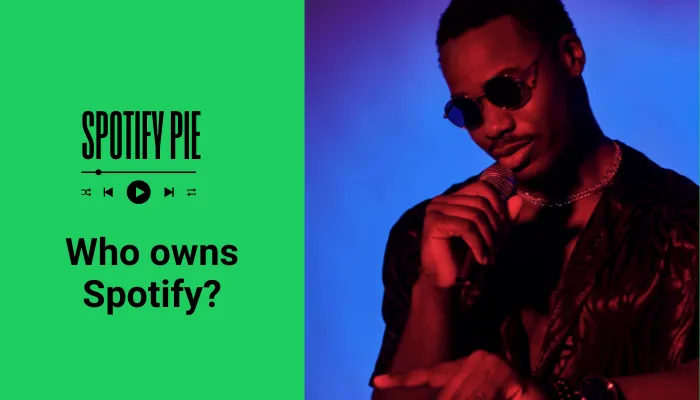Spotify has changed how we consume music. So, Who Owns Spotify? No more carrying around MP3 players or downloading illegally. Today, millions of people worldwide rely on Spotify for their everyday music discovery and personalized playlists.
However, the tale behind the rise of Spotify is not just about a handy app. It involves innovation, strategic partnerships, and a well-considered ownership structure.
This article narrates the incredible journey of Spotify, with great emphasis on some key figures that shaped its success story. We will explore from where it began as a response to piracy in music to its current status as a publicly traded company with an ardent following.

Seeds Of A Revolution In Streaming Music
The start of Spotify lies in one problem: music piracy. Napster was among many illegal file-sharing platforms upon which they were rampant in the early 2000s thus threatening the whole industry inclusive of music.
This was when two Swedish entrepreneurs – Daniel Ek and Martin Lorentzon – came up with this legal and user-friendly alternative.
Spotify came into being in 2006—the platform had a huge library that was available via a free-to-premium model whereby users could listen for free alongside occasional ads or pay to have no ads at all.
Early Challenges And Milestones
Landing licensing deals with big record labels proved difficult but eventually paved the way for fair compensation for artists by Spotify.
The creation of a strong music library as well as an easy-to-use interface were critical factors that would bring users from piracy services.
Strategic partnerships with mobile handset makers helped it make early headway into an expanding market for smartphones like any other technology-driven start-up just out there!
Venture Capital to Public Offering
A solid financial backing was what allowed Spotify’s growth; let us consider its funding history through two stages:
The first round of investments was made by well-known VC companies like Sequoia Capital and Index Ventures. These investments enabled Spotify to develop its technology, secure licensing agreements, and increase its customer base.
VC funding often comes with the expectation of rapid growth that may have driven Spotify’s aggressive expansion strategy.
Strategic Partnerships
This game-changing move involved cooperation with top record labels such as Universal Music Group, Sony Music Entertainment, and Warner Music Group.
To entice and keep users, these collaborations provided access to a wide catalog of music.
Nevertheless, label partnerships also entail ownership issues whereby major labels could have negotiated their own rights or royalties in connection with their content.
A New Chapter of Ownership
Spotify went public in 2018 on NYSE – symbol SPOT. This allowed for new investors:
Nowadays Baillie Gifford & Co., T Rowe Price, and Morgan Stanley are among large institutional shareholders at Spotify. These investors hold significant stakes in Spotify and want it to succeed over time; they can influence strategic decisions via the vote power available to them too.
A scrutiny of shareholders’ voting powers explains who controls the company eventually. Understanding Spotify’s ownership structure is important, this indicates who decides for tomorrow of the company.
Eventually, Spotify is a story about innovation, strategic alliances, and well-crafted ownership. It has enabled the consumption of music in ways that were not conceivable when it was founded as a response to piracy. As Spotify expands its business operations, one will need to understand how many people own some part of it and why are these individuals motivated by doing so.
Who Owns it, and Who Leads it?
Music consumption has been revolutionized by Spotify. But the story behind the iconic green button goes far beyond just playlists and podcasts. This article takes a deep dive into the ownership, leadership, and company culture that drives this music giant.
The Man Behind the Music
Undoubtedly, Daniel Ek is the face of Spotify as its co-founder and CEO. His journey was one of ambitiousness and adaptability.
- From Napster to Spotify: Ek had become disillusioned with file-sharing platforms such as Napster because he imagined a legal and sustainable way to access music. This vision led to Spotify, which balanced artist compensation with user convenience through a freemium model.
- A Leader with a Mission: Ek’s style of leading is characterized by an innovation-centered approach plus believing in giving employees power. In response to this commitment, there is a unique “squad” structure at Spotify that does away with conventional hierarchies and replaces them with self-organizing teams.
- Steering the Ship: With Martin Lorentzon (the other co-founder), they control significant shares in Spotify therefore having immense influence over its affairs. Although this authority helps him make future-oriented decisions without worrying about immediate earnings, it can also raise questions about accountability.
Ownership & Spotify Tribe
Spotify’s ownership principles go beyond its founders only; below are some highlights:
- Equity for Everyone: Unlike traditional corporate structures, Spotify provides each employee with an opportunity to own stock options thereby fostering ownership sense and shared success.
- Empowered Innovation: Employee ownership creates an ownership culture through accountability. Squads have powers for decision-making purposes and experimentation resulting in more dynamic work environments that foster innovation within organizations.
- The Spotify Perspective: Employee satisfaction surveys often show positive responses on the company’s shareholding structure since members feel like they belong here and can influence its future directly.
Acquisitions and the Expanding Universe
Music streaming is not the only thing Spotify has limited itself to. Here are some aspects of their acquisition drive:
- Strategic Purchases: Spotify’s important acquisitions include, for example, podcast platform Anchor and audiobook service Findaway with a view to enlarging library content base and expanding user groups.
- Beyond Music: These acquisitions illustrate Spotify’s intention to become a one-stop destination for audio services by maybe trying out areas such as live streaming or personalized audio experiences.
- Diversification for Growth: Diversification enables Spotify to venture into new revenue sources while reducing dependency on any single market. Meanwhile, it also makes them leaders in the changing audio environment.
Conclusion
In conclusion, “Who Owns Spotify?” The combination of founder control, employee ownership, as well as public listing make up an exclusive dynamic that shapes its decision-making processes and long-term vision. How does this ownership structure affect short-term profits versus long-term growth strategies?
For its sustainable financial responsibility, it must maintain an innovation balance while ensuring that it has a corporate culture that attracts and retains top-notch employees where they are headed from here.
As a result, nothing about Spotify’s ownership structure is just mere technicality. It demonstrates the core values of the company; a vision of management; guarantees given to subordinates and consumers.
